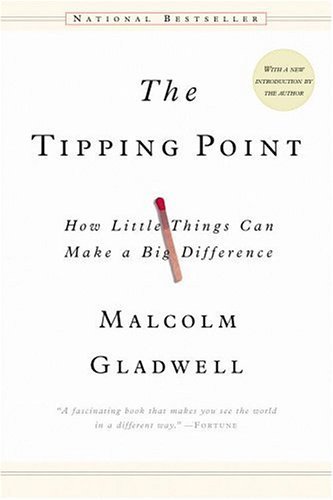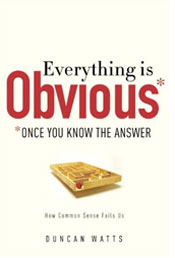The Tipping Point
Saturday, November 1st, 2014 | Books
Malcolm Gladwell is a man who lies for money. Actually, I do not know that. In fact, if I was to guess, I would guess that he geniunely believes what he writes. I however, am far more skeptical about the claims he makes.
Take for example the 10,000 hours rule. This is based on a study done by Anders Ericsson. Ericsson however, does not agree with Gladwell. In fact in 2012 he wrote an entire paper on it entitled “The Danger of Delegating Education to Journalists”. Gladwell’s response? To claim that Ericsson has wrongly interpreted his own study.
Approaching with a sensible amount of skepticism then, I took on Gladwell’s book The Tipping Point: How Little Things Can Make a Big Difference.
The first section talks about the law of the few. This explains how a few key individuals (such as connectors who are people that know everybody, and mavens who know lots of information on say supermarket prices) are the key to many things in our society. He cites the popular idea of the six degrees of Kevin Bacon where you can connect almost all actors to each other through Kevin Bacon.
He then talks about stickiness. How sticky in the message? He cites an example of a leaflet telling students to get a tetanus shot. It turned out that it did not matter how many horrible photos and descriptive language they used in the leaflets – the percentage of students actually going and getting the shots remained at 3%. Yet when they included a map and opening times of the on-campus health centre, this rose to 28%, even though all the students must have known where the health centre was.
In the third section, he goes on to talk about the power of context. Quoting the example of the drastic crime drop in New York City, he espouses the broken window theory. This is the idea that if you leave a broken window people will think nobody cares about the area and crime will increase, whereas if you fix it right away people will see people care and stop committing crime.
There are some strong rebuttals to what Gladwell writes however.
In the case of the law of the few, Gladwell cites a Milgram experiment where he had people send on packages to try and get to someone in a different city. He found that most packages made it, and most of them went through a few key individuals. Gladwell calls these people connectors. However, when Duncan Watts, author of Everything is Obvious, replicated the study, he found that connectors were not important.
In the case of the broken windows theory, this was one of the case studies in Freakonomics, in which the books shows that while everyone in New York was patting themselves on the back for their brilliant new policing strategy that was cutting crime, what had actually happened was that two decades ago they had legalised abortion, and now all the would-be criminals were simply never being born.
Malcolm Gladwell is a man who lies for money. Actually, I do not know that. In fact, if I was to guess, I would guess that he geniunely believes what he writes. I however, am far more skeptical about the claims he makes.
Take for example the 10,000 hours rule. This is based on a study done by Anders Ericsson. Ericsson however, does not agree with Gladwell. In fact in 2012 he wrote an entire paper on it entitled “The Danger of Delegating Education to Journalists”. Gladwell’s response? To claim that Ericsson has wrongly interpreted his own study.
Approaching with a sensible amount of skepticism then, I took on Gladwell’s book The Tipping Point: How Little Things Can Make a Big Difference.
The first section talks about the law of the few. This explains how a few key individuals (such as connectors who are people that know everybody, and mavens who know lots of information on say supermarket prices) are the key to many things in our society. He cites the popular idea of the six degrees of Kevin Bacon where you can connect almost all actors to each other through Kevin Bacon.
He then talks about stickiness. How sticky in the message? He cites an example of a leaflet telling students to get a tetanus shot. It turned out that it did not matter how many horrible photos and descriptive language they used in the leaflets – the percentage of students actually going and getting the shots remained at 3%. Yet when they included a map and opening times of the on-campus health centre, this rose to 28%, even though all the students must have known where the health centre was.
In the third section, he goes on to talk about the power of context. Quoting the example of the drastic crime drop in New York City, he espouses the broken window theory. This is the idea that if you leave a broken window people will think nobody cares about the area and crime will increase, whereas if you fix it right away people will see people care and stop committing crime.
There are some strong rebuttals to what Gladwell writes however.
In the case of the law of the few, Gladwell cites a Milgram experiment where he had people send on packages to try and get to someone in a different city. He found that most packages made it, and most of them went through a few key individuals. Gladwell calls these people connectors. However, when Duncan Watts, author of Everything is Obvious, replicated the study, he found that connectors were not important.
In the case of the broken windows theory, this was one of the case studies in Freakonomics, in which the books shows that while everyone in New York was patting themselves on the back for their brilliant new policing strategy that was cutting crime, what had actually happened was that two decades ago they had legalised abortion, and now all the would-be criminals were simply never being born.

